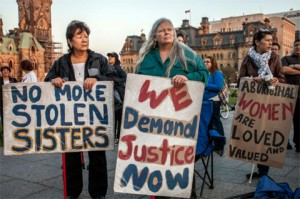In 2010 the Native Women’s Association of Canada initiative called Sisters in Sprit created a database of missing and murdered Aboriginal women and girls, listing 582 cases. While the oldest case dates back to 1944, majority of the cases they researched were recent, with 39% of all the cases between 2000 and 2010. Though this data is a few years old, Cheryl Maloney (the president of the Nova Scotia Native Women’s Association) said in a CBC article that “Aboriginal women are still five times more likely to be violently attacked than non aboriginal people.” Ultimately this issue is still very prevalent in society, as seen by the very recent, tragic story of Loretta Saunders, a 26 year old St. Mary’s University student who was murdered by her two former roommates. Saunders was an Inuk woman, who was writing a thesis on missing and murdered indigenous women specifically in Nova Scotia. As an aboriginal woman herself she was very involved with the issue, and as Darryl Leroux (her thesis supervisor) said,“she had a passion for supporting indigenous youth [to] overcome the many barriers they face.”
Her body was found just two days ago, and so as the most recent missing and murdered women case her story exemplifies how pressing the issue of violence against aboriginal women is all across the country in our current society. I noticed that in many of the articles about her death by different news outlets there seemed to be a common pattern of family, political figures and groups such as The Assembly of First Nations calling for action on the issue of missing and murdered women. In a CTV article the Assembly of First Nations Chief Sean Altleo, said in response to Saunders death, “this is a call to action that this must end now. We cannot add one more name to the list of murdered or missing women. We need to see action by all parties to end violence, to respect and honour women and families, to ensure our communities are safe and secure for all.”
 This call for action has even been taken up by Amnesty international in partnership with Sisters in Spirit in a campaign called “No More Stolen Sisters: Justice for the missing and murdered Indigenous women of Canada”. They call for a movement of truth and justice and have also called upon the government to act in order to stop violence against women. Ultimately this issue is not only a social issue but a human rights issue that effects the whole country, and so it is important that groups such as Amnesty International, and the Assembly of First Nations speak out to make their voices heard.
This call for action has even been taken up by Amnesty international in partnership with Sisters in Spirit in a campaign called “No More Stolen Sisters: Justice for the missing and murdered Indigenous women of Canada”. They call for a movement of truth and justice and have also called upon the government to act in order to stop violence against women. Ultimately this issue is not only a social issue but a human rights issue that effects the whole country, and so it is important that groups such as Amnesty International, and the Assembly of First Nations speak out to make their voices heard.

By reading Missing Sarah by Maggie De Vries, the issue of missing and murdered women in Canada, and specifically on the Downtown Eastside became evident. Now, with the news coverage on Loretta Saunders’ situation, it is really sinking in the severity of this issue. Maggie De Vries comes from a position of privilege, and was able to speak out for her sister’s case and give her a voice. Loretta made the news and was a “special” case since her dissertation was on missing and murdered women, and so she too has had a moment to be “heard.” I wonder what this means for other missing and murdered women, specifically aboriginal women, who slip under the radar and are not given the chance to be acknowledged, and are just part of the statistic.